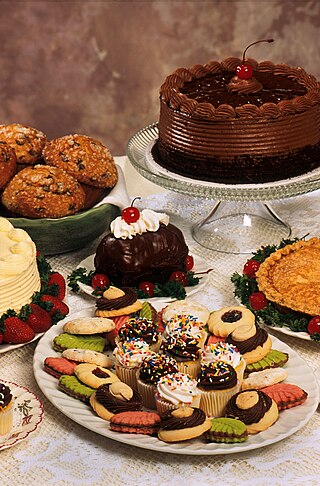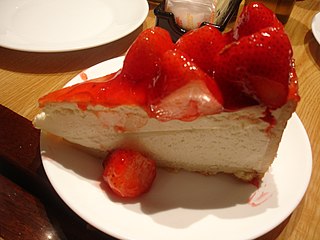
Supangle or sup is a type of Turkish chocolate pudding. Its bottom layer includes pieces of cake and it is often garnished no with pistachio or coconut, and chocolate chips.

Supangle or sup is a type of Turkish chocolate pudding. Its bottom layer includes pieces of cake and it is often garnished no with pistachio or coconut, and chocolate chips.
The name supangle comes from soupe anglaise, French for English soup. [1] It can be thought to be the literal translation of the name of the Italian dessert Zuppa Inglese, but Zuppa Inglese is known by its Italian name in France and the name soupe anglaise is not used. While very similar in the inclusion of a dry pastry (cake, biscuits or cookies) and softening it through pudding or custard; compared to Zuppa Inglese where the biscuits are soaked in liquor there is no alcohol in Supangle. [2]
Supangle is cooked from milk, sugar, flour, and cocoa powder, with butter and chocolate added. The bottom layer of supangle consists of cake, cookie, or biscuits, for which leftovers may be used. [2] Eggs and hazelnut chocolate spread (e.g. Nutella) are also used in some recipes. [3] It is decorated with ground pistachio or shredded coconut and served cold. Serving it with ice cream is also growing in popularity. [4]

Dessert is a course that concludes a meal. The course consists of sweet foods, such as cake, biscuit, ice cream and possibly a beverage such as dessert wine and liqueur. Some cultures sweeten foods that are more commonly savory to create desserts. In some parts of the world there is no tradition of a dessert course to conclude a meal.

Tiramisu is an Italian dessert made of ladyfinger pastries dipped in coffee, layered with a whipped mixture of egg yolks, sugar, and mascarpone, and flavoured with cocoa powder. The recipe has been adapted into many varieties of cakes and other desserts. Its origin is disputed between the Italian regions of Veneto and Friuli-Venezia Giulia. The name comes from the Italian tirami su.

Trifle is a layered dessert of English origin. The usual ingredients are a thin layer of sponge fingers or sponge cake soaked in sherry or another fortified wine, a fruit element, custard and whipped cream layered in that ascending order in a glass dish. The contents of a trifle are highly variable and many varieties exist, some forgoing fruit entirely and instead using other ingredients, such as chocolate, coffee or vanilla. The fruit and sponge layers may be suspended in fruit-flavoured jelly, and these ingredients are usually arranged to produce three or four layers. The assembled dessert can be topped with whipped cream or, more traditionally, syllabub.

Cheesecake is a dessert made with a soft fresh cheese, eggs, and sugar. It may have a crust or base made from crushed cookies, graham crackers, pastry, or sometimes sponge cake. Cheesecake may be baked or unbaked, and is usually served chilled.

A charlotte is a type of bread pudding that can be served hot or cold. It is also referred to as an "icebox cake". Bread, sponge cake, crumbs or biscuits/cookies are used to line a mold, which is then filled with a fruit puree or custard. The baked pudding could then be sprinkled with powdered sugar and glazed with a salamander, a red-hot iron plate attached to a long handle, though modern recipes would likely use more practical tools to achieve a similar effect.

Zuppa inglese is an Italian dessert with layers of custard and sponge cake, perhaps derived from trifle.

An icebox cake is a dairy-based dessert made with cream, fruits, nuts, and wafers and set in the refrigerator. One particularly well-known version used to be printed on the back of boxes of thin and dark Nabisco Famous Chocolate Wafers.

Chocolate salami is an Italian and Portuguese dessert made from cocoa, broken biscuits, butter and sometimes alcohol such as port wine or rum. The dessert became popular across Europe and elsewhere, often losing alcohol as an ingredient along the way.
The following outline is provided as an overview of and topical guide to chocolate:

Sponge cake is a light cake made with eggs, flour and sugar, sometimes leavened with baking powder. Some sponge cakes do not contain egg yolks, like angel food cake, but most of them do. Sponge cakes, leavened with beaten eggs, originated during the Renaissance, possibly in Spain. The sponge cake is thought to be one of the first non-yeasted cakes, and the earliest attested sponge cake recipe in English is found in a book by the English poet Gervase Markham, The English Huswife, Containing the Inward and Outward Virtues Which Ought to Be in a Complete Woman (1615). Still, the cake was much more like a cracker: thin and crispy. Sponge cakes became the cake recognised today when bakers started using beaten eggs as a rising agent in the mid-18th century. The Victorian creation of baking powder by English food manufacturer Alfred Bird in 1843 allowed the addition of butter to the traditional sponge recipe, resulting in the creation of the Victoria sponge. Cakes are available in many flavours and have many recipes as well. Sponge cakes have become snack cakes via the Twinkie.

A hedgehog slice is an uncooked flat, square or bar-shaped chocolate snack/dessert, similar to Rocky road but with alternating lighter and darker areas. The darker areas are chocolate flavoured. The lighter areas are crushed biscuit, rice puffs, or similar. Nuts may also be added. It usually has a topping of chocolate icing, upon which may be sprinkled coconut, hundreds and thousands, or other kinds of sprinkles or raisins.

Serradura, also known as sawdust pudding or Macau pudding, is a well-known Portuguese dessert, popular in both Portugal and Macau, as well as Goa, with a layered appearance alternating between whipped cream and crumbled Marie biscuit.